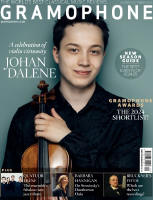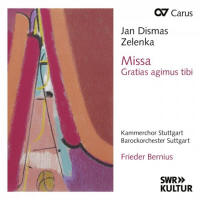Texte paru dans: / Appeared in:
|
|
|
|
|
|
Bohemian double-bass player Zelenka acted as de facto Hofkapellmeister at the Dresden court’s Roman Catholic chapel from the start of his superior Heinichen’s protracted health problems until long after the eventual appointment of Hasse. Frieder Bernius – longstanding champion of Zelenka’s sacred music – presents four works composed between 1725 and 1730. Headline billing is granted to the Missa Gratias agimus tibi (October 1730). An incongruously optimistic Kyrie and convivial Gloria have graceful solo turns, polished interjections from the disciplined Stuttgart Chamber Choir, refined natural trumpets, tightly controlled timpani and precise strings. The suave quartet ‘Laudamus te’ has a lovely moment for soprano Hannah Morrison accompanied by flutes. On the other hand, three-part choral polyphony offers beguiling suspensions in ‘Qui tollis peccata mundi’. The Credo has an intimate trio ‘Et incarnatus est’ (soprano, alto and tenor accompanied only by lute and organ) and a solo alto ‘Crucifixus etiam pro nobis’ sung beseechingly by David Allsopp. Zelenka’s compositional eccentricities are to the fore in the peculiar opening chorus of the Sanctus, but there are sweetness and long honeyed phrases from solo tenor Thomas Hobbs paired with delicate flute and oboe obbligatos in the Benedictus. At the centre of the Agnus Dei is a quartet for exclusively high voices (originally Italian castratos) with translucent flutes over quietly whispering violins.
A concise Magnificat (November 1725) alternates full forces with nonchalant concertante passages that were designed to display the talents of castrato Andrea Ruota and violinist Johann Georg Pisendel, their function reincarnated here by Morrison and concertmaster Friedemann Wezel. The contrapuntal closing ‘Amen’ is shaped gorgeously by the choir. Also dating from November 1725, a through-composed
Laudate pueri Dominum accords pride of place to the agility and poeticism of bass Jonathan Sells accompanied by lightly shaded continuo cellist Juris Teichmanis and organist Bernward Lohr, whereas neatly crafted ‘choral’ responses for a trio of two sopranos and alto tend to be unaccompanied. Bernius and his Stuttgart ensembles conclude with Beatus vir (March 1726). Hobbs and Sells duet dulcetly in tandem with the excellent choir, ‘Gloria, Patri et Filio’ is an ardent soprano arioso performed exquisitely by Morrison, and the doxology finishes with an accomplished choral ‘Amen’ fugue. |
|




